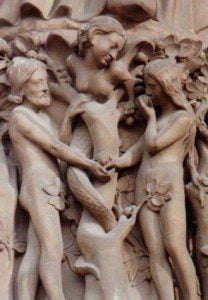 One of the questions raised by the evolutionary view of human origins is where, exactly to place Adam and the origin of the human race created in the image of God. Were there pre-Adamic humans? Are or were some “humans” (however we define human evolutionarily) not created in the image of God? However, this isn’t only a problem for evolutionary biology. It cropped up before evolution came into the picture, although it is clear that evolution muddies the waters even more. What are we to make of Neanderthals? Denisovans? Other populations we have yet to discover? Modern genetics tells us that these populations of hominids have contributed to the genetic make-up of segments of modern humans, but not all humans.
One of the questions raised by the evolutionary view of human origins is where, exactly to place Adam and the origin of the human race created in the image of God. Were there pre-Adamic humans? Are or were some “humans” (however we define human evolutionarily) not created in the image of God? However, this isn’t only a problem for evolutionary biology. It cropped up before evolution came into the picture, although it is clear that evolution muddies the waters even more. What are we to make of Neanderthals? Denisovans? Other populations we have yet to discover? Modern genetics tells us that these populations of hominids have contributed to the genetic make-up of segments of modern humans, but not all humans.
Several years ago I read and posted on David Livingstone’s book Adam’s Ancestors: Race, Religion, and the Politics of Human Origins. This is a book I enjoyed reading, so it was a real pleasure to meet David Livingstone at the Evolution and Christian Faith Workshop last month, and to have an opportunity to talk about the book among other things. Given our recent focus on the question of Adam, Adam’s Ancestors is a book that warrants another look and some edited reposts and today we have the second installment.
The history of the discussion of Adam and pre-adamic man has several major streams – from skeptical undermining of the Christian narrative to Christian apologetic; monogenism (a single origin for all of humanity), polygenism (multiple origins for humankind), and racial superiority. These threads are present in the early 1600’s and are active even now, some four hundred plus years later.
Apologetics: Pre-adamism and the Harmony of Science and Religion. Livingstone sketches a variety of approaches taken in the nineteenth century to find ways to synthesize what was being learned from investigation of the world with the accounts of origins found in scripture. Darwin’s The Origin Of Species did not start this activity – it was well underway before Darwin published. But Darwin’s theory did contribute to the mix. The key factors early on were the issues of geological age, the fossil record, and the discovery of tools and artifacts (and eventually human fossils) that predated any reasonable date for a literal Adam as calculated from the biblical genealogies. Another consideration – one we often don’t consider much today, but should – was the history of language and the evolution of language.
Livingstone gives a fascinating discussion of the kinds of issues confronting Christians in the 1800’s – and the responses they devised. Two hermeneutical approaches were generally used to reconcile science and scripture; a gap between Genesis 1:1 and 1:2 or a distinction between the creation narratives of Genesis 1 and Genesis 2-3.
The “gap” … In the early 1800’s Scottish evangelical intellectual Thomas Chalmers and Oxford geologist William Buckland among others popularized the idea of a gap of unspecified length between Genesis 1:1 and Genesis 1:2.
John Harris, Congregationalist clergyman and later principle of New College, London published The Pre-Adamite Earth in 1846 and Man Primeval in 1849 both of which had unoccupied geological ages and a six day Adamic creation.
Where Harris went beyond these standard concordist schemes was in his attempt to craft a metaphysic capable of mounting a robust defense of the idea that pre-adamite earth history was orchestrated by the Creator to be the theatre for human occupancy. (p. 83)
Herbert William Morris writing ca. 1870-1890:
Here then is a Hiatus – a vast gap – in the Mosaic narrative which it is important to observe. Between the creation of the earth, as stated in the first verse, and the condition in which it was found and described, in the second verse, there must have elapsed a long and indefinite period of time. (p. 85)
Two creations – successive human races. As evidence of human artifacts and later human remains in strata with long extinct animals came to light these narratives came to include pre-adamic people. Isabelle Duncan writing in 1860 suggested that the two Genesis stories reflect two creation narratives – the first, Genesis 1 is a pre-adamic creation. The six days are long ages and “the events of Creation must have passed in six successive visions before the mind of Moses.” Duncan’s pre-adamic world was populated by animals and by humans. The presence of “pre-adamic” human artifacts, but absence of “pre-adamic” human remains was explained by bodily resurrection to become the Angelic Host. James Gall, on the other hand saw “a botched humanity under the influence of satanic forces” in the pre-adamic artifacts and remains. George Hawkins Pember speculated that demons might be “the spirits of those who trod this earth in the flesh before the ruin described in the second verse of Genesis. (p. 93)”
The approach in all three cases – Duncan, Gall and Pember – was concordist, a direct attempt to reconcile new discoveries in archaeology and paleontology with the Biblical account.
Polygenism. Some thinkers and apologists took a concordist approach in a somewhat different direction. Harvard naturalist Louis Agassiz, as a prime example, sought a concordist approach that accounted for pre-adamic and non-adamic man and the diversity of mankind in a polygenic creation. Separate origins served to reconcile science and scripture and to provide a rational for racism. The lines of argument in these apologists, and Agassiz is only one of many, show a tendency to value scripture, to seek a concordance between science and scripture, and to justify and sanctify a deeply ingrained racism.
And we could continue – the history of relationship between languages spawned a substantial literature.
What lessons can we learn? Livingstone concludes chapter 4:
In their encounter with the new geology and emerging human sciences, religious believers turned to the idea of a pre-adamite earth and pre-adamite races in order to retain solidarity between scientific knowledge and theological creed. … It facilitated the revelations of deep time that the geologists were exposing even while preserving a relatively recent date for the Mosaic story of Adam; it allowed room for archaeological excavations of primitive artifacts and, later, human remains; it offered a means of untangling the complex genealogy of human languages; and it provided an explanation for racial differences without postulating an extended biblical chronology. Securing these gains took many forms. For some the pre-adamite earth was uninhabited, … For others entire pre-adamic civilizations had populated the primeval earth, … According to some, these residents were entirely wiped out before the advent of Adam; others were sure that pockets of pre-adamites survived to intermarry with Adam’s progeny. (p. 107-108)
Why was all this industry so important? In large part, of course, it was motivated by a passion to retain good faith with religious heritage in the face of scientific challenges. But it also sprang from the fundamental importance of the adamic picture to the Christian West’s sense of its own identity, culture, and worth. (p. 108)
An undercurrent of racial and cultural superiority permeates the entire discussion. Preserve scripture – for sure – but also preserve the “status quo” as they saw it. The whole discussion is a mix of desire to follow God and defend scripture mixed with cultural blinders and human frailty.
Race, religion, and the story of Adam’s ancestors in US history. The story of pre-Adamism in the US takes a particularly ugly turn from the mid 1800’s through the early 1900’s (and beyond). Chapters 7 and 8 of Livingstone’s book are depressing as he relates the discussion.
The “American School” of polygenetic racial science was a determined effort to place the inferiority of non-Caucasian races on firm scientific grounds. According to this school we are not one species. But the data was read in a fashion that supported the hypothesis – the underlying view of the scholars.
The collective endeavors of the American School, however short-lived their scientific standing, brought a variety of additional rhetorical devices into the discussion. Statistical measurement, visual imagery, and the cultivation of what might be called moral cartography were all conspicuous features of the project. Consider first Mortonite numerology. His statistizing practices were scrutinized by Stephen Jay Gould, who uncovered something of how what he referred to as an unconscious “finagling” of the data delivered findings perfectly fitted to Morton’s racial tastes. By ignoring dependent variables such as age and sex, generalizing from atypical groups, and so on, Morton could supply a convenient hierarchy, with Caucasians comfortably located on top, Native Americans in the middle, and the Africans at the bottom. (p. 175)
Livingstone continues on to outline much of this discussion – most, but not all, with either goal or result, assigning a place to white European peoples as natural leaders and justifying slavery and exploitation.
Monogenesis was no better. Many within the church, especially within the South, disagreed with the scientific polygenism. However, they achieved the same cultural result – white supremacy and the defense of slavery – on biblical grounds. As Livingstone puts it “scientific anthropology bestialized slavery; adamic theology sanctified it.” (p. 182) Southern Christians saw in the curse of Ham a justification for a paternalistic God ordained slavery. To give one example, John Bachman refuted Morton’s scientific argument case by case believing that polygenism undermined both scripture and Christian civilization.
Yet none of this meant that advocates of the unity of the human race were committed to egalitarianism, still less abolition. The idea of black inferiority was just too ingrained for that. Bachman, for example, staunchly defended southern slavery and argued, on the basis of the biblical curse of Ham, that the black races were designed, and destined, for servitude. He considered the “Negro [to be] a striking and now permanent variety” who might improve through intermarriage with whites – a morally repugnant price to pay for racial enhancement. (p. 182)
Later Livingstone notes:
To all of them the Bible sanctioned slavery, and abolitionists and polygenists alike were undermining its supreme authority. Humane Christian slavery, they believed, was under attack from two radically different sources: an opportunistic abolitionism fueled by northern greed and economic self-interest; and a degenerate anthropology that would dehumanize whole races. (p. 183).
In the postwar era more turned to pre-adamism and polygenism. Reading of the nature of the fall took, for some, a decidedly racist turn. The sin of Eve was sexual in nature – sometimes enticed by a black pre-adamite, sometimes by a handsome Mongolian. The nature of Eve’s sin was mingling the blood of the the pure adamic line with non-adamic races. Livingstone concludes:
Why clergy turned to pre-adamism from the standard Hamitic narrative that, for southerners, had long been sufficient to provide an account of African origins and a justification for slavery lies, I think, in pre-adamism’s capacity to serve as a tool to combat interracial mixing in ways that the Hamitic account never could. By identifying distinct adamic and pre-adamic bloodlines, white supremacists couldconstruct a bio-biblical dogma that allowed traditional loyalty to the Bible to draw on a melange of scientific specialties. (p. 200).
The discussion of the racial politics of pre-adamism in Adam’s Ancestors does not touch upon evolution other than in passing. Polygenists by and large were opposed to evolution as it would serve to unite the races. Of course, Darwinism and social Darwinism were used to achieve some of the same ends achieved by pre-adamism, polygenism, and the Hamitic narrative.
Rationalization and rhetoric. The underlying theme in all of the positions outlined above is not the authority of scripture or the authority of science. In all of these cases science and/or scripture were twisted to defend and rationalize a conclusion already deeply embedded in the consciousness and culture of the time. Sola scriptura doesn’t provide a firm foundation, surety against error – nor does tradition or reason. This is a lesson that should remain in our consciousness, front and center. I have little doubt that we as a whole will be judged as missing the mark in important ways.
Where today are we twisting scripture to support our errors?
Where today are we twisting science to justify ourselves?
How do we, as Christians, know when our reading of science or scripture is truth, or an honest search for truth, and when it is wish-fulfillment and rationalization?
If you wish to contact me directly you may do so at rjs4mail[at]att.net
If interested you can subscribe to a full text feed of my posts at Musings on Science and Theology.












